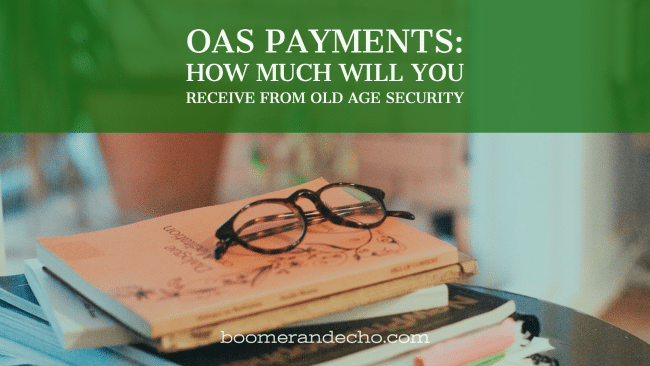OAS Payments: How Much Will You Receive From Old Age Security


Old Age Security (OAS) is a government program in Canada that provides a basic income to eligible seniors who have reached the age of 65. It is one of the three main pillars of Canada’s retirement income system, along with the Canada Pension Plan and personal savings.
Eligibility for OAS is based on several factors, including age, residency, and income. To receive OAS payments, you must be 65 years of age or older and have lived in Canada for at least 10 years after the age of 18.
OAS is considered taxable income. As of January 2024, the OAS maximum payments from age 65 to 74 is $713.34 per month ($8,560.08 per year), and $784.67 per month ($9,416.04 per year) for those ages 75 and older.
The amount of OAS you receive is based on how long you’ve lived in Canada after the age of 18. If you have lived in Canada for less than 40 years, you may receive a partial pension. For instance, if you lived in Canada for 35 out of the 40 eligible years you would be entitled to receive 87.5% of the OAS maximum payment (35 divided by 40).
The amount you receive may be reduced if your income exceeds a certain threshold, which is $86,912 for the income year 2023. If your income exceeds this amount, your OAS payment will be reduced by 15 cents for every dollar of income above the threshold. This OAS “recovery tax” period takes place the following year (July 2024 to June 2025).
Since July 2013, most eligible seniors are automatically enrolled to receive OAS starting at age 65. The government determines your eligibility the month after you turn 64. If eligible, you will be notified of your automatic enrolment beginning at age 65. That means, if you are still working or simply plan to defer taking your OAS benefits to age 66 to 70, you should contact Service Canada to declare your voluntary deferral.
Otherwise, to apply for OAS, you must complete an application form and provide proof of age and residency. You can apply up to 11 months before you turn 65, and you should receive your first payment within three months of your application being approved.
To apply online you’ll need a My Service Canada Account (MSCA).
In addition to OAS, there are other government programs that may be available to eligible seniors, including the Guaranteed Income Supplement, the Allowance for Spouses, and the Allowance for Survivors. These programs provide additional income to low-income seniors and their spouses or survivors.
Overall, Old Age Security is an important program that provides a basic income to eligible seniors in Canada. While the amount of OAS you receive may vary based on your income and residency, it can provide a valuable source of income in retirement. If you are approaching the age of 65, it is important to consider your eligibility for OAS and other government programs that may be available to you.
Deferring OAS to age 70
Deferring Old Age Security to age 70 is an option for Canadian seniors who have the financial capacity to do so. By delaying your OAS payments, you can increase the amount you receive each month.
For each month that you delay your OAS beyond age 65, your pension will increase by 0.6%, up to a maximum increase of 36% if you delay OAS until age 70. This means that if you delay your OAS for five years, you will receive 36% more per month than you would if you started collecting at age 65.
However, it is important to carefully consider whether delaying your OAS is the right choice for you. If you have a shorter life expectancy or if you need the money to cover your living expenses, it may be better to start collecting your OAS at age 65.
Additionally, delaying your OAS may affect your eligibility for other government programs that are based on your income. For example, if you delay your OAS and receive a higher pension at age 70, your income may be higher and you may no longer be eligible for certain programs, such as the Guaranteed Income Supplement.
Overall, delaying your OAS to age 70 is an option that can provide a higher monthly pension, but it may not be the right choice for everyone.
OAS Payment Dates 2024
The OAS payment dates for 2024 are:
- January 29, 2024
- February 27, 2024
- March 26, 2024
- April 26, 2024
- May 29, 2024
- June 26, 2024
- July 29, 2024
- August 28, 2024
- September 25, 2024
- October 29, 2024
- November 27, 2024
- December 20, 2024
Payment dates may vary depending on your payment method. If you receive your OAS payments by direct deposit, it should be deposited into your account on the payment date. If you receive your payment by cheque, it may take a few additional days to arrive by mail.
OAS is Indexed to Inflation
While Canadians can expect their CPP payments to increase annually based on the previous year’s Consumer Price Index, OAS recipients have their benefits adjusted quarterly to provide better protection against unexpected sharp increases in prices over the year.
The quarterly inflation adjustment for OAS benefits is based on the difference between the average CPI for two periods of three months each:
- the most recent three-month period for which CPI is available, and
- the last three-month period where a CPI increase led to an increase in OAS benefit amounts.
OAS payments starting in the first quarter of 2024 were indexed by 0.8%.
OAS Payments Increase at age 75
In July 2022, the Canadian government announced an increase to the OAS pension for seniors aged 75 or older. Starting in July 2022, the OAS pension for seniors aged 75 or older was automatically and permanently increased by 10%.
If you turn 75 after July 1, 2022 you will receive the increase in the month following your 75th birthday.
The 10% increase in the maximum OAS pension rate will not affect the calculation of your Guaranteed Income Supplement (GIS).
The increase to the OAS pension for seniors aged 75 or older is in recognition of the increased costs and challenges that seniors face as they age. The government hopes that this increase will provide additional support to seniors and help them maintain a good standard of living in their later years.
OAS Clawback Threshold
The Old Age Security (OAS) clawback threshold is the income level at which your OAS payments will be reduced or “clawed back”. The OAS clawback is designed to ensure that OAS payments are targeted to those who need them the most, by reducing or eliminating payments for those with higher income levels.
The OAS clawback threshold for the income year 2023 is $86,912. This means that if your net income (which includes income from all sources, such as employment, pensions, investments, etc.) exceeds this amount, your OAS payments will be reduced by 15 cents for every dollar of income above the threshold.
For example, if your net income was $91,912 in 2023, which is $5,000 above the clawback threshold, your future OAS payments will be clawed back by $750 (15% of $5,000). This “recovery tax” period takes place from July 2024 to June 2025.
If your net income exceeds $142,124 in 2023, your OAS payments will be fully clawed-back during the OAS recovery tax period the following year (July to June).
The timing and mechanics of this is important to note.
Let’s say you applied for OAS benefits upon turning 65 in June 2023. You earned $145,000 in 2023 due to a variety of income sources, including capital gains from the sale of a rental property. You file your 2023 taxes in April 2024 and CRA determines that your taxable income that year has exceeded the OAS clawback threshold.
Meanwhile, you’ve been receiving OAS payments monthly since July 2023. You won’t get a bill to repay the approximate $8,292 you received in OAS benefits between July 2023 and June 2024. Instead, your repayment amount is deducted from your ongoing OAS payments as a recovery tax starting in July 2024.
You will receive a letter informing you of any recovery tax deductions being withheld from your OAS pension payments.
*Changes in OAS Eligibility (not happening)*
Back in 2015, the federal government led by Stephen Harper proposed changes to OAS eligibility – increasing the age of eligibility from 65 to 67. This would have gone into effect as of April 1, 2023 and be fully implemented by January, 2029.
This proposal was quickly repealed when the federal Liberal government was elected in 2015. It’s not happening, folks.
You can continue to apply for OAS benefits and receive them starting at age 65.
Final Thoughts
OAS is a complicated system but one that is critical to retirement planning for many Canadians. It’s important to understand how much OAS you can expect to receive in retirement, and when you plan to take your OAS benefits (between ages 65 to 70) to maximize your income and minimize any clawbacks.
Speaking of clawbacks, it’s also important to understand that OAS benefits are means-tested, meaning once your income rises above a certain threshold your benefits will be clawed-back by 15 cents for every dollar above that threshold. In some cases, OAS benefits may be completely clawed back.
It’s important to work with a financial planner who can help you understand how the timing of retirement, crystallizing capital gains, and withdrawing from an RRSP or RRIF can impact when you should take your OAS benefits and whether your benefits will be clawed back.
It’s also important to note the advantage of pension income splitting with a spouse (for defined benefit pension income and RRIF / LIF income at age 65 and beyond), and how this helps avoid OAS clawbacks in many cases.
OAS payments are indexed to inflation and benefits are adjusted quarterly to keep pace with inflation (versus CPP, which is adjusted annually in January).
Will you take your OAS at age 65, or do you plan on deferring OAS to age 70? Do you have strategies in place based on retirement, capital gains, RRSP/RRIF withdrawals, that will impact when you decide to take OAS?





